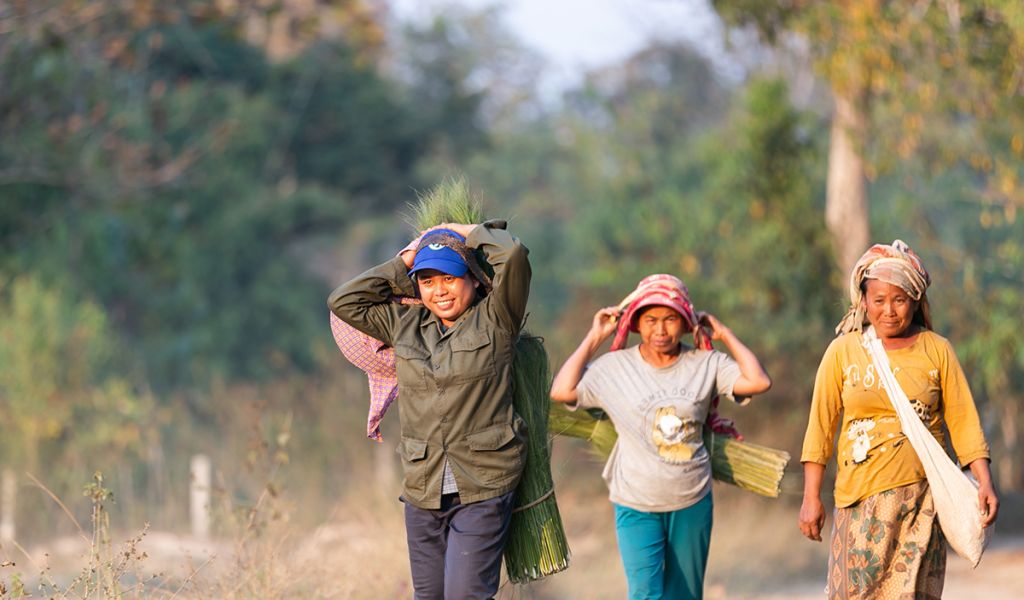Investing in people and forests for climate and nature goals: The case for core funding

At the COP28 climate change conference in Dubai, the climate and nature agendas started to align like never before. To those of us who work with communities that depend on forests, this is long overdue. But there is still much to do.
As recent research has affirmed, community forestry is a nature-based solution that brings multiple benefits — for people, economies, biodiversity and the climate. Ensuring that those benefits flow is not simple. It requires training, network building, research, advocacy, testing of interventions — and close collaboration among governments, communities, businesses, academia and civil society organizations. This is long-term work needing long-term funding.
The organization I lead, RECOFTC, focuses on strengthening capacities, rights and governance to ensure that communities can maintain and benefit equitably from sustainable forest landscapes in the Asia-Pacific region. We are fortunate that a fifth of our funding comes in the form of long-term monetary and technical support from the Swiss Agency for Development and Cooperation (SDC) and the Swedish International Development Cooperation Agency (Sida).
Without this core funding and support, RECOFTC could not have developed sustainable finance mechanisms for community forestry, or innovative programs such as our WAVES initiative on gender equality in the forest sector. From 2019 to 2022, WAVES supported 31 inspiring individuals in seven countries as they advocated for equality and led gender-mainstreaming programs in the government agencies, nongovernmental organizations, businesses and universities where they work. WAVES provided these gender champions with training, mentoring and funding. While the first phase of this program has ended, the network it created continues to have impacts. A new phase of the WAVES project is under development.
Core funding is key to organizational effectiveness
Core funding allows organizations to pursue our own priorities using our own approaches, better meeting needs in diverse local and national contexts. It also allows us to invest in people, equipment and systems, enhancing our own productive capacities. Crucially, it enables us to innovate and makes us more effective at achieving our strategic objectives.
Evidence that core funding is effective comes from the International Development Research Centre’s Think Tank Initiative (TTI). Between 2009 to 2019, it provided core funding to 43 independent policy research organizations in Africa, Asia and Latin America.
According to the TTI, this “led to higher quality research, stronger policy engagement, greater application of effective communications practices, and enhanced organizational performance. [It] enabled think tanks to act more strategically and intentionally in positioning themselves for influence.”
But core funding is an exception. In a 2022 survey of 50 African conservation organizations conducted by Maliasili and Synchronicity Earth, 92 percent of these organizations identified a lack of core funding as a barrier to them achieving their objectives. This is the case for Asia as well. More and more donor funding is coming to the region through short-term project support with definitive targets set by global mandates.
In 2017, flows of official development assistance going through civil society organizations for project implementation were nearly six times greater than flows going to such organizations to support their operations. A lack of core funding limits an organization’s autonomy, flexibility and ability to grow. It also increases transaction costs associated with fundraising, project administration, reporting requirements, and so on.
The standalone projects that bilateral donors typically fund average around two to five years in duration. But it can take a year to set up a project, including acquiring necessary government permissions. And it can take six months or more to conclude and report on the work. This leaves very little time for actual implementation on the ground.
Donors can do more
RECOFTC’s core donors, SDC and Sida, take a longer and more regional view, supporting multi-phase projects of up to ten years. This allows for adaptive management from phase to phase, and for development interventions to take place over longer timeframes.
In a field like forestry, where is takes decades to get a forest to recover, or for management regimes to reach fruition, it is refreshing to have donors with a long-term perspective and a longstanding commitment to community forestry. I would like more donors to follow their example, especially given global interest in using nature for climate change adaptation and mitigation.
In November 2023, government ministers from 32 of the largest providers of development assistance committed to increase their “impact and effectiveness”. Meeting under the auspices of the Organization for Economic Cooperation and Development’s Development Assistance Committee, they issued a communiqué outlining this and other commitments. They agreed to produce a revised strategy in 2024 “that ensures we adapt and modernize our ambitions and instruments”.
The communiqué highlights climate change, environmental degradation and biodiversity loss among key global challenges that donors must focus on. The new strategy should include targets for increasing the share of core funding in the support they provide to organizations working on these issues.
This would unlock so much potential and increase the effectiveness of the work these organizations do. In RECOFTC’s case, it would help us to support communities in their efforts to manage forest landscapes sustainably, improving livelihoods and outcomes for nature in ways that contribute to global goals on climate change and biodiversity loss.
Sources
Fischer, H.W. et al. 2023. Community forest governance and synergies among carbon, biodiversity and livelihoods. Nature Climate Change 13: 1340-1347. https://www.nature.com/articles/s41558-023-01863-6
Hibler, M. et al. 2019. TTI Insights: Making the case for core funding. IDRC-CRDI, Ottawa, Canada. https://tti.idrc.ca/content/making-case-core-funding.html
Paul, R. et al. 2022. Greening the Grassroots: Rethinking African Conservation Funding. Maliasili and Synchronicity Earth. https://www.synchronicityearth.org/wp-content/uploads/2022/07/Greening-the-Grassroots-July2022.pdf
Wood, J. and Fällman, K. 2019. Enabling civil society: Select survey findings. OECD Development Co-operation Working Papers, No. 57. OECD Publishing, Paris. https://doi.org/10.1787/54903a6a-en.
###
RECOFTC’s work is made possible with the support of the Swiss Agency for Development and Cooperation and the Swedish International Development Cooperation Agency.

